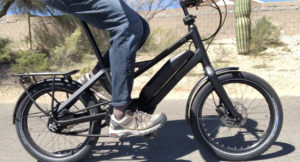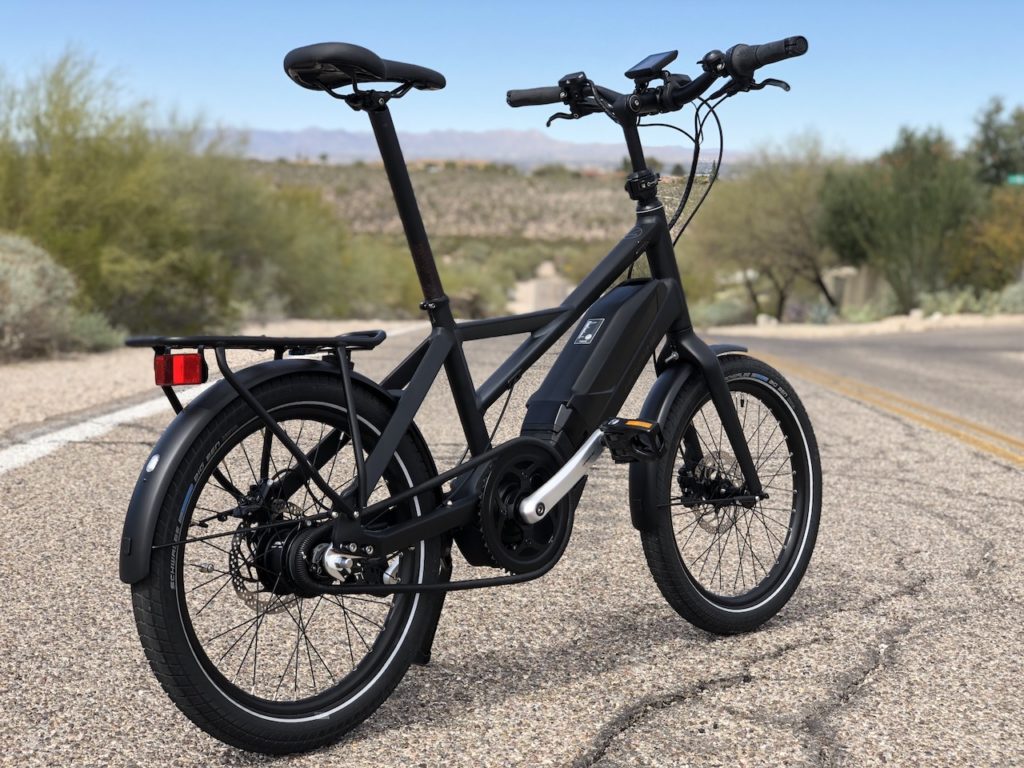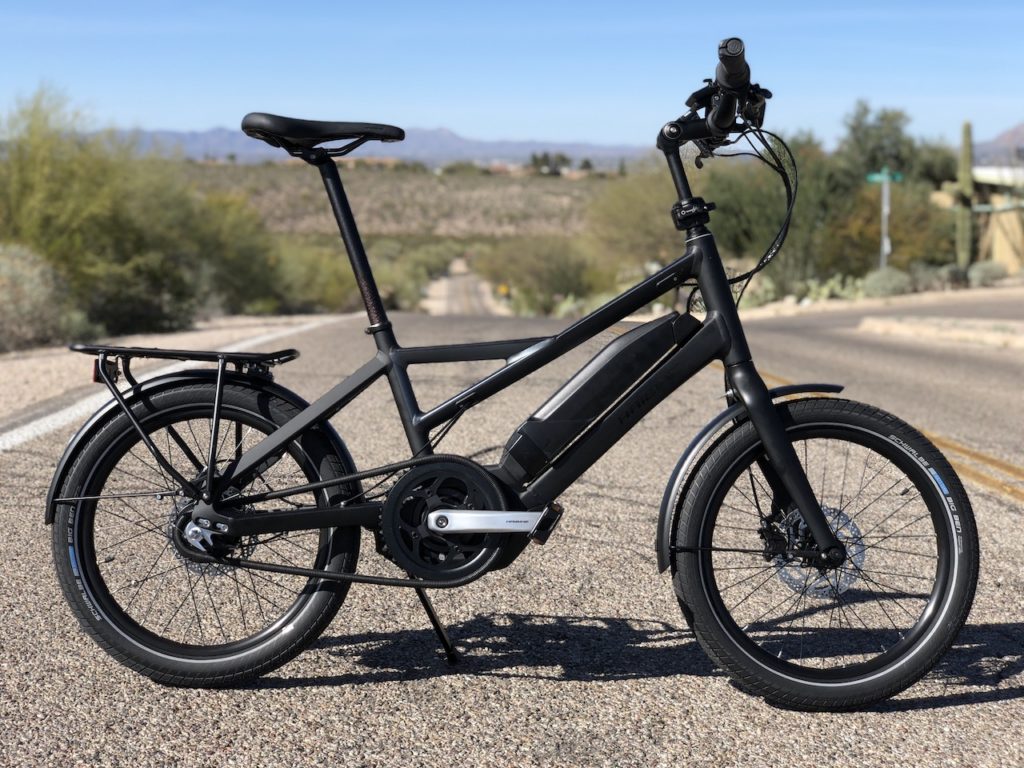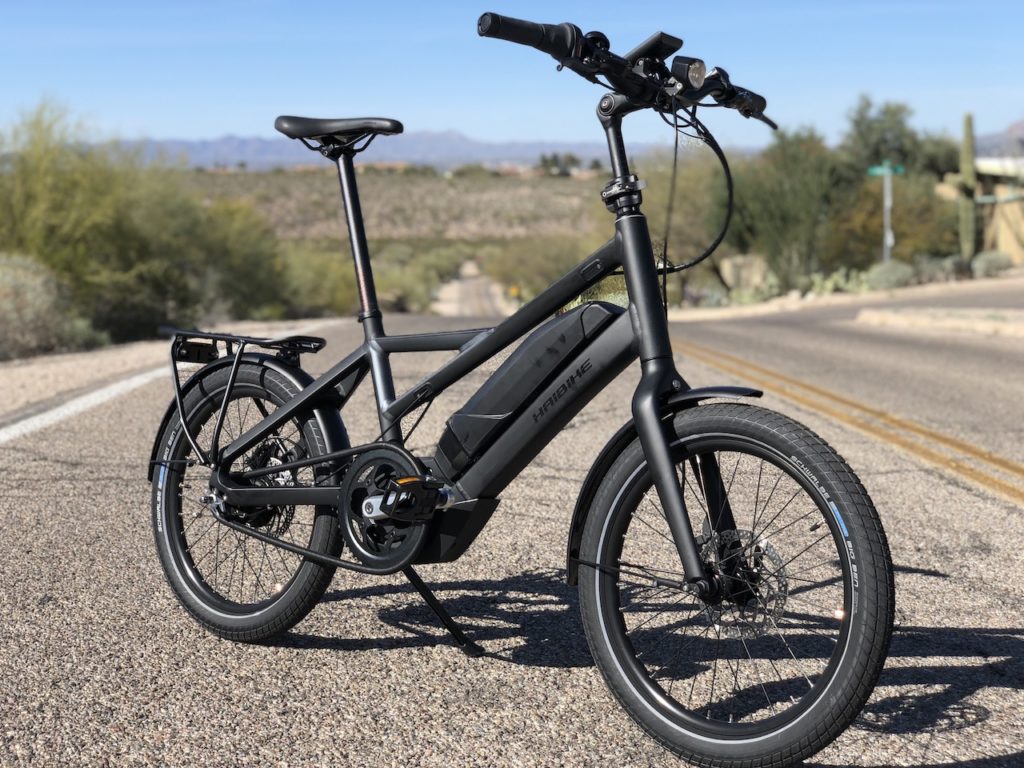Haibike Radius Tour Electric Bike Review Part 2: Ride & Range Test [VIDEO]
 After many miles of testing the Haibike Radius Tour it has proven to be a powerful and sporty compact electric bike with impressive range.
After many miles of testing the Haibike Radius Tour it has proven to be a powerful and sporty compact electric bike with impressive range.
The powerful Yamaha PW 500 watt mid drive combined with the quick acceleration of the 20″ wheels give the Radius Tour a fun performance feel.
Its solid low step frame and wide Schwalbe balloon style tires give it a stable ride feel that is also easy to ride.
This compact eBike is very adjustable to fit many rider sizes and ride styles. It can also be come very compact for storage and portability.
The Haibike Radius Tour is priced at $3,000 USD.
In this second part of the full review you will get an idea of the ride characteristics, range test results, pros, cons, and overall thoughts on this electric bike.
Make sure you check out part 1 of this review with large pictures and specifications to get a detailed look at this e-bike.
What you can expect from the Haibike Radius Tour:
To get acquainted with the Haibike Radius Tour, here is a video to give you a closer look:
Riding the Haibike Radius Tour:
Overall there are some characteristics of the Haibike Radius Tour that really stand out when riding this eBike. To summarize they are:
- An easy riding and agile compact eBike
- Powerful and sporty ride feel with impressive range
- High quality ride feel with a solid component mix
The Look & Feel of the Haibike Radius Tour

A 6061 aluminum frame with hydroformed tubes is designed with a relatively low step over area near the center of the frame.
Getting on and off the Radius Tour is pretty easy which is nice when running quick errands around town.
The hydroformed aluminum tubes have a variety of interesting shapes ranging from triangular, rectangular, to the standard round tubes.

The extra triangle created by the top tube reinforcement tube adds to the style of the bike and offers a nice handle hold for picking the bike up.
The central battery location on the downtube combined with the mid drive motor creates a very centered weight distribution for the bike. This is good for overall handling of the bike in addition to making it easier to pick up.

There is a lot of adjustability in the handlebar and seat post height so you can fit the bike to your size and preferred riding position.
It is currently equipped with a 450mm seatpost that does a good job of fitting many riders. I am 5′-11″ with a long inseam and at the maximum extension of the seatpost I am not able to get the full leg extension.
There may be a 550mm seatpost option in the future for the Radius Tour that will fit taller riders.

The stem angle can also be adjusted to provide more height and changes to the reach.
Another interesting feature is that the handlebar can be quickly turned 90 degrees (while keeping the front wheel straight) for storing in narrow areas and/or for portability.
In addition, the pedals are foldable which helps to keep the overall profile very narrow.
While the Haibike Radius Tour is not technically a folding eBike it can become very compact by dropping the seat and handlebar, turning the handlebar, and folding the pedals.
Its overall small footprint is good for storing in a small living space or for transporting in a car, truck, or van.
In addition to being compact for storage and portability its relatively small size has some benefits for the ride feel.
Getting on and off the bike is easy with its low step area and 20″ wheels.

The Haibike Radius Tour corners quickly and the compact size works well in congested areas. In some ways it has the feeling of a BMX bike that can accelerate quickly while being very agile in the corners.
Compared to some folding bikes the Radius Tour frame feels very solid with minimal flex.
Smaller wheels do require more a bit more attention because they are not as forgiving as larger wheel bikes.
Bumps, crack, and potholes in the road are more abrupt because they don’t roll over or through those obstacles as well as larger 26″ or 29″ wheels.

Schwalbe describes it well, “The Big Apple started off the Balloonbike trend ten years ago: Comfortable cycling without using complicated technology! Air cushion tires are used as natural suspension.”
When you run these in the lower pressure range (~30 psi) they have that suspension effect and it does help quiet a bit with the small bumps and cracks in the road.
The Big Ben tires are also capable of easy going dirt road riding which can be nice for exploring new routes around town or fun adventure rides.
Flat tires from thorns, glass, etc. are minimized with the RaceGuard puncture resistant liner built in to the tires.
Now let’s take a closer look at the ride position of the Haibike Radius Tour.
As mentioned before there is a lot of adjustability to the dial in the best fit and ride position for you with the highly adjustable stem and seat post.
You can set up the Radius Tour in a comfortable upright position that also helps for seeing everything around you. Or you can set it up for more of a hunched over performance riding position that is more efficient for longer rides.

The Haibike saddle has a mid-width profile with a center relief section that is pretty comfortable for performance style rides.
Now let’s take a closer look at how the Haibike Radius Tour eBike system and drivetrain performs.
While the Radius Tour may have a compact look to it, the Yamaha PW mid drive motor really gives this bike some kick!
At 500 watts of power with up to 80 Nm of torque the Yamaha PW provides solid sustained power for maintaining near 20 mph on moderate climbs.
In the higher assist levels the bike has a sporty, punchy feel because of the motor power and the small wheels that are agile and can accelerate quickly.

The Yamaha system does a nice job of blending the electric assist with your pedal power. It uses 3 sensors (torque, cadence, speed) to monitor your ride style and then provide you with the proportional assist based on the assist level you have selected.
The assist starts and stops as soon as you start pedaling and the transitions between no power to full power are very smooth.

The Haibike Radius Tour is a Class 1 electric bike per California law (other states are adopting similar laws) because it is pedal assist only up to 20 mph and less than 750 watts of power.
There are 4 different levels of pedal assist: Eco+, Eco, Standard, High. The pedal assist levels are adjusted with the up or down arrow buttons on the control pad.
The Eco+ and Eco levels give you a moderate amount of assist for an easy going ride around the neighborhood and/or if you want to get more of a workout. They are good modes for getting the most range out of the bike.

There is a walk mode button on the bottom of the control pad but it is not active for US models. So far it is only available for the European market.
Like a lot of mid drives, the Yamaha PW motor does some noise. At the lower speeds and higher pedaling cadences you can hear a whirring noise that tends to fade away as wind noise overtakes it at higher speeds.
One interesting component of the Radius Tour is the Chainrunner chain guard that rotates with the chain. It consists of a slotted casing made of highly flexible corrugated tube that protects your pant legs from getting greasy.
It works well and there doesn’t seem to be any noise when using it.
The Chainrunner is intended to keep the dirt out which should reduce the lubrication cycles. It is recommended that the cover be removed for lubrication and then reinstalled.

Internally geared hubs consolidate all of the gearing with the rear hub for a very clean system compared to a cogset with derailleur.
The Shimano Nexus 8 speeds cover the gear range well for many riding conditions including steep hills. A benefit to the Nexus hub is that you can shift the gears when you are not pedaling.
This is good for when you want to get into the best gear ratio for accelerating from a stop or when transitioning quickly from a decent to a climb.

When climbing hills under substantial power it hesitates shifting to an easier gear. Once the power is reduced it will make the shift but that is difficult when you really want to maintain as much momentum on a climb.
There is a grip shifter on the right side of the handlebar that allows you to quick shift through multiple gears in one twist. A gear level indicator is located on the grip shifter.
The Yamaha PW system and the front and rear lights are powered by the 36V 13.6ah 500 Wh lithium battery that is well positioned in the main frame of the bike.
The battery weighs 6.60 pounds and it is removed by unlocking it with the supplied key and sliding the battery to the side.
With the battery removed the bike weighs 42.65 pounds. Removing the battery makes it a little easier to load into a car, RV or boat.
The battery can be fully charged from empty in about 4 hours with the included charger that is a little larger than a laptop charger.
Now let’s take a closer look at the Yamaha display that is located in the center of the handlebar.
The display provides information on:
- Battery level
- Pedal assist level (there are 4 levels: Eco+, Eco, Standard, High)
- Current speed
- Power level that the motor is contributing
- Average speed
- Max speed
- Odometer
- Trip distance
- Estimated range remaining
- Cadence in RPM
- Current time
It is very easy to see the info at a quick glance because the display is large and center on the handlebar. There is a backlight in the display for seeing it while riding at night.
The power level is interesting to watch because you can see how much the motor is contributing based on how much you are pedaling and the pedal assist level used.
The control pad on the left side of the handlebar is positioned well and the buttons are large enough and well laid out for easy adjustments while riding.
There is also has a small USB charging port that you can use to charge a smartphone when you are out and about.

These hydraulic brakes have a high quality feel with their extremely solid engagement. The stopping power is impressive and they modulate well between just a little braking to full braking for a quick stop.
The brake levers can be adjusted to fit the size of your hand so that the brake levers are easily within reach.
Haibike equipped the Radius Tour well with a full assortment of accessories for commuting and longer tour rides.
The front (Spanninga Kendo, 15 lux) and rear (Busch & Müller Xeltec) lights are built into the bike and they are powered by the eBike battery so you don’t have to worry about charging separate batteries for the lights.
The SKS plastic fenders have a solid structure and they blend in well with the overall bikes look.
An aluminum rear rack provides a platform to carry bags or baskets. The stated max cargo weight is 55 pounds (25 kg). It features a spring clip on top to easily carry some small cargo like clothing or a small box.
To round out the accessory package there is the bell on the right side of the handlebar and a solid kickstand.
Okay, let’s see how the Haibike Radius Tour did out on the open road!
Haibike Radius Tour Range Test Results:
Here is the real world information on how the Haibike Radius Tour electric bike performed on a riding circuit that includes hills, flats, traffic, wind (when available) etc.
While testing these bikes I like to put them through the toughest conditions to see where their bottom line is in regards to range and speed. I tested the Haibike Radius Tour the highest pedal assist level (High) with average pedaling on paved roads.
Range: As you can see from the GPS info that I recorded, the Haibike Radius Tour traveled 33 miles and did a total elevation gain of around 2,700 ft. Considering that I weigh 190 lbs and I pedaled at an average pace this is very good range for a 36 Volt 13.6 ah battery pack (500 Watt Hours) with a 500 watt motor assisting up to 20 mph.

Please keep in mind that if you pedal more, weigh less than me, ride slower and/or you use the bike in terrain that is not as hilly you will get more range. These results are from tough testing.
Speed: The Haibike Radius Tour will assist up to 20 mph with pedal assist.
Weight: The Haibike Radius Tour tips the scales at 49.25 lbs which is a moderate weight for a compact electric bike. Removing the battery brings it down to around 42.65 pounds which makes it a little easier to carry or load into a vehicle.
The weight distribution of the Haibike Radius Tour is very good because the battery is in the front part of the frame and the mid drive motor is centered on the bike. All of that weight is low which is great for overall bike handling.
Pros:
Powerful & Sporty Ride Feel with Impressive Range: The powerful 500 watt Yamaha PW mid drive motor and the nimble 20″ wheels with a solid frame gives the Haibike Radius Tour a very sporty performance ride feel in the higher assist levels. It is impressive that the Radius tour went 33 miles with 2,700+ ft of climbing in the highest assist level. More moderate riding will provide more range.
Easy Riding: The Radius Tour is a very approachable eBike with its low step frame for ease of getting on and off the bike. The 20″ wheels are agile with wide tires for a stable ride feel. It’s highly adjustable stem and seatpost will fit many riders and the bike can be dialed in to fit your preferred riding position.
Portable & Storable: Even though the frame doesn’t fold the Radius Tour can become quickly compact and narrow for storage at home, work, or in a vehicle for easy storage and transport.
Cons:
Shifting Under Power: When shifting to an easier gear under power the Shimano Nexus internally geared rear hub hesitates. Once the power is reduced it will make the shift but that is difficult when you really want to maintain as much momentum on a climb.
Motor Noise: Like a lot of mid drives, the Yamaha PW motor does some noise. At the lower speeds and higher pedaling cadences you can hear a whirring noise that tends to fade away as wind noise overtakes it at higher speeds.
Conclusion:
Overall the Haibike Radius Tour is a nimble, sporty, and compact eBike that is good for everyday commuting and longer fun rides.
The powerful Yamaha PW 500 watt mid drive motor system and agile smaller wheels makes the Radius Tour an impressive performance eBike that is comfortable to ride.
Its adjustability helps with dialing in the fit of the bike and it is also helpful for creating a compact bike for storage and/or transport.
The Haibike Radius Tour features a high quality mix of components from Yamaha, Shimano, and Schwalbe for the price of $3,000 USD.
Please keep in mind that this is a relatively short term test. This testing can’t really give you the long term review of durability and reliability. My thoughts on the quality of this bike are from previous experiences with similar bikes. If you own this bike and have some input on the long term durability, please share your comments with the Electric Bike Report community below.
Where to buy a Haibike Radius Tour? Check with the Haibike website.
Do you have any questions about the Haibike Radius Tour? Do you own a Radius Tour? Please share your thoughts in the comment section below.
Thanks!
-Pete
Review Note: Each company pays a fee for a review on Electric Bike Report because of the considerable amount of time that it takes to provide an in-depth review of each eBike. A lot of time is spent on the full range test with distance & elevation profile, the wide variety of detailed pictures, in-depth video, and the write up with the specifications, ride characteristics, pros, cons, and overall thoughts. The reviews on Electric Bike Report are focused on providing you with a detailed “virtual” look at each eBike to help you determine if it is the eBike for you.
P.S. Don’t forget to join the Electric Bike Report community for updates from the electric bike world, plus ebike riding and maintenance tips!
Reader Interactions
Comments
Trackbacks
-
[…] Part 2 of the Haibike Radius Tour review will give you info on the ride characteristics, results from the range test, pros, cons, and overall thoughts on this eBike. […]












Pete, shifting a Nexus Internally geared hub with either manual or motor power applied is a no no. This will most certainly damage the shift pawls inside the hub. Stop pedalling for 1 sec. shift & then start pedalling again. Used this way you will find the shifts on the Nexus are almost imperceptible. Down shifts should be performed the same way but may not always be so seamless. Another tip – I have found that Shimano hubs from new are shipped with a bare minimum of lubrication so it is a good idea on a brand new hub to check that it is adequately greased or oiled. Using this hub with an 80 nm electric motor I would be concerned with it’s durability.